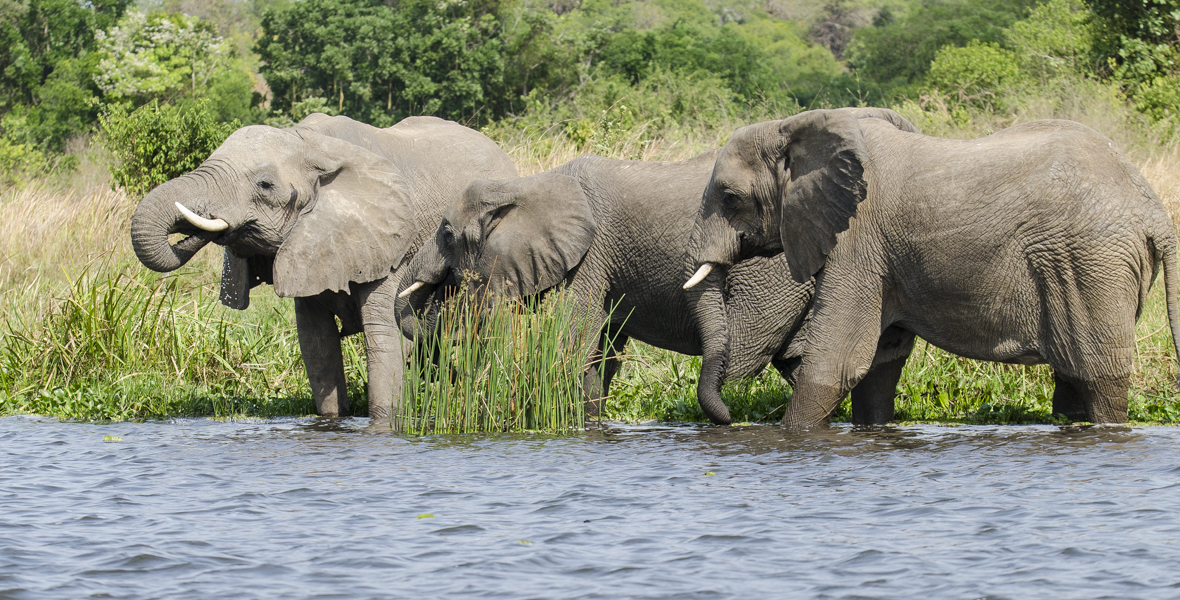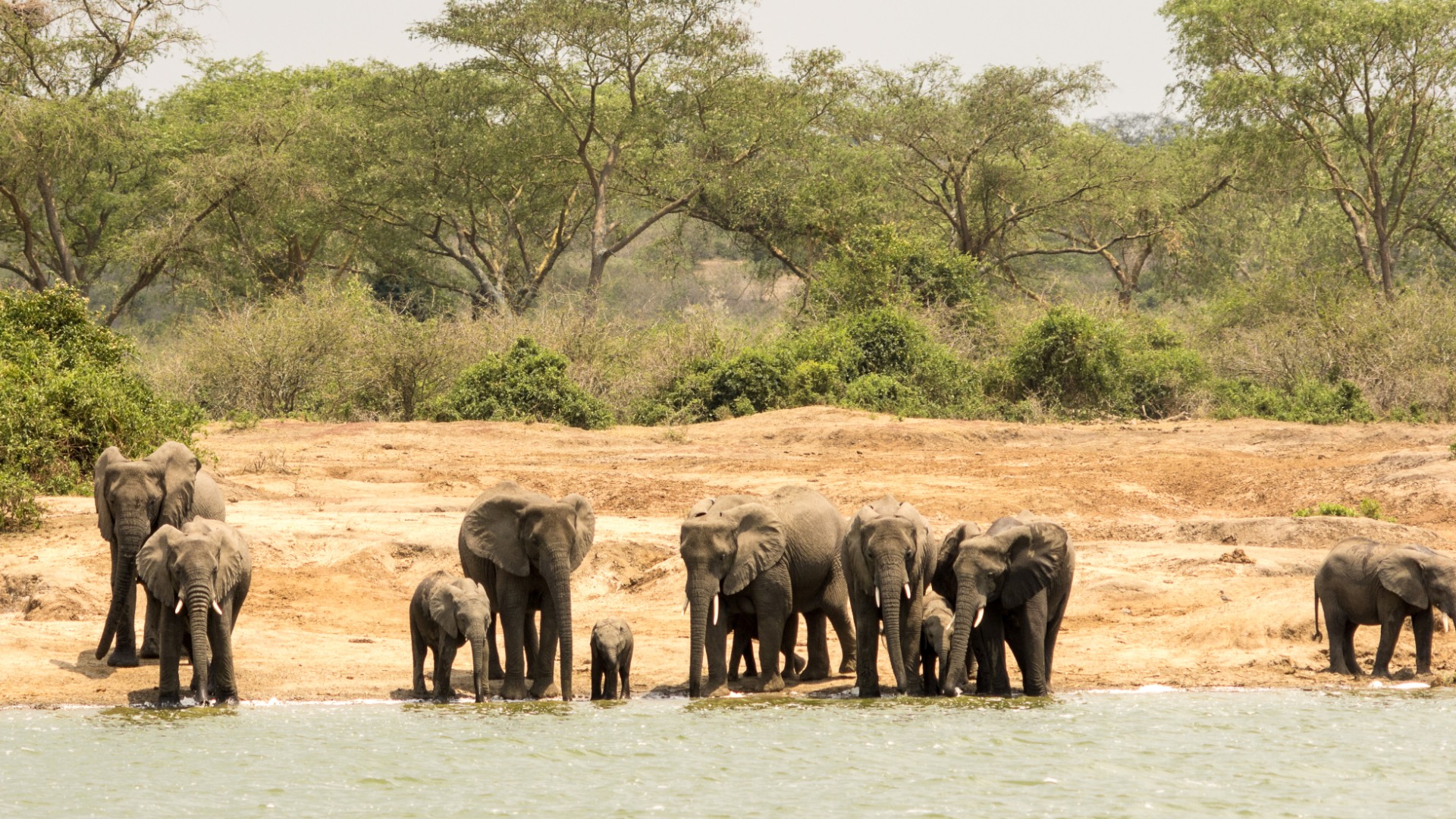Elephants have the longest pregnancy on earth
At 22 months, elephants have the distinction of having the longest gestation period of all animals and give birth to live young ones. Pregnancy almost always results in a single birth; twins are rare, when it’s time to give birth, female elephants move away from the herd and then return to introduce the new member who is inspected by each member of the family. At birth, babies weigh 90-120kgs and are typically around 3ft tall. Baby elephants tend to be hairy with a long tail and a short trunk that grows as its diet changes. Off springs are weaned at 2 years, though some may continue to nurse up to 6 years and a half. Because of this long gestation and nursing period, estrus cycles are between 4-6 years apart, on average, a female elephant will give birth to 7 off springs in her life time. The off springs are cared for by the mother and other female members until 8 years and females occasionally nurse young ones other than their own. When threatened by predators, adult females will form a protective ring around the young elephants; females stay in the female group while males eventually are driven away.
Read Here about the Secrets of African Elephants
Feeding habits of elephants
Elephants may spend 12-18 hours a day feeding. They manipulate food and bring it to the mouth using their trunk with different food types such as pulling up along grass with the trunk, while short grass is loosened and kicked into a pile with the forefeet, then swept up in the trunk. African elephants, unlike Asian elephants apparently do not combine the use of the trunk and a fore leg to break branches, although they will break branches using their trunks tip. Elephants may travel for considerable distances to reach rare trees while they are fruiting and may also travel rapidly to the vicinity of an isolated shower to make use of the lush grass growing following the rain. Feeding rates may vary considerably between males and females, in different habitats and at different times o the day are affected by the amount of preparation required to eat the food as well as by degree of hunger.

Elephants usually drink at least daily and at least every few days, they suck water up with the trunk then squirt it into the mouth. They can drink rapidly by this method 4-6 litres per trunk full and 80-160 litres in only 5mins. They are generally thought to prefer fresh flowing water but have been seen to drink a muddy wallow despite the presence of clean lake water just meters away. They make difficult dangerous journeys to reach water and in drought conditions use the feet and trunk to dig wells in sandy dry river bottoms to reach water.
Under natural conditions, elephants eat mostly grass, tree leaves, flowers, wild fruits, twigs, shrubs, bamboo and bananas, their main food is grass when available along with some leaves. But if the weather turns dry and grass dies back, they will eat almost any kind of vegetation they can find. Tree bark is a favorite food source for elephants, it contains calcium and roughage which aids digestion, tusks are used to carve into the trunk and tear off strips of bark, they drink about 18-26litres of water daily, an adult elephants can drink up to 212 litres of water in about 5mins. To supplement the diet, elephants dig up earth to obtain salt and minerals. The tusks are used to churn the ground. The elephant then places digested pieces of soil into its mouth to obtain nutrients. Frequently these areas result in holes that are several feet deep and vital minerals are made accessible to other animals. Overtime, African elephants have hallowed out deep carves in a volcano mountain side on the Ugandan border to obtain salt licks and minerals. Hills have been carved by Asian elephants in India and Sumatra searching for salt and minerals, these carved areas in the landscape provide valuable food and shelter resources for a diverse array of native wildlife.
How they communicate
Elephants are extremely intelligent creatures which show great range of social behavior including complex communication techniques and emotional displays. The most well known of course is trumpeting. Elephants trumpet to signal distress or excitement, they also make roaring sounds when charging. Elephants use infrasonic sound for communication as well; there sound frequencies are too low for us to hear, these sounds are capable of travelling for very long distances through the ground, these sounds are usually for signaling something to the whole herd of elephants. Male elephants sometimes go into a state known as musth, the hormone testosterone increases with their body by tenfold or more and their behavior changes drastically, they become extremely aggressive during musth, they make a distinct rumbling sound during this. Elephants also use many other touch and visual signals for communication, a mother and baby use their trunks to touch each other to communicate, calves for example will touch their mother’s teat with their trunk to indicate that they want to suckle.
Mothers are known to slap calves with their trunks to discipline them, elephants touch each others’ temporal glands with their trunks which helps them pick up smells and odors for chemical signals. Various physical displays are used to communicate during fights or confrontations, they can spread their ears and stand tall with trunks raised to seem more threatening when covered or fighting. On the other hand, to indicate submission, they might flatten their ears and lower their trunks. Elephants are amazing creatures which are highly intelligent and have an extremely range of social behavior. Each has an extreme range of social behavior, each individual has its own individual personality.
How they protect and defend their territories
Elephants are not territorial, they are nomadic animals that travel in the matriarchal or female led societies. Male elephants are usually solitary but in nature they may associate with other adult males or better known as bulls in small groups that constantly gain and lose members. Elephants usually have a home range from 10-70sqkm and possibly larger depending on the size of the herd and the season. Elephant’s physiology is designed to support a nomadic style with an average daily distance covered being 17km, they often have the stereotypical behavior of rocking back and for as a response to lack of movement, it is thought that elephants are nomadic due to their destructive feeding behavior. They literally push down the environment surrounding them due to their large mass. Elephants tend to knock down trees daily to strip bark or reach high leaves.
They also kill large areas of grass grazing. In some instances, elephants will use their tusks to mark trees to establish territory of their home range. Bulls associate in small groups that have a hierarchical ranking structure that is constantly in flux. This means leaders constantly change depending on the size, age and strength when members leave and enter. They don’t seek leadership roles but rather adapt to their dominance by sparring which is usually determined by size and strength. Their nomadic social system allows for maximum reproductive possibilities, with this lifestyle, bulls can potentially find up to 30 mates in a year. Female elephants associate in concentric rings, with the innermost ring comprising of related female adults. This family units can have sizes from 3-25members, the most dominant female usually the oldest is called Matriach and usually determines the ranging patterns for the family.
Lifespan of elephants
Elephants can live up to 70 years in the wild. The truth, however, is that few reach that age. African elephants live a median of 56 years in the wild, while Asian elephants live about 42 years. Many animals live longer in captivity than they do in the wild, simply because being captive means there are no predators around. However, the elephant is an exception. According to an article in National Geographic News, elephants in zoos live shorter lives than elephants in the wild. And the differences are pretty significant as well: an average of 17 years in a zoo against 56 in the wild. Although scientists are not sure why this happens, two possible reasons are obesity — and the health issues this carries — as well as the stress of captivity.

